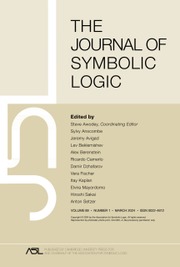Article contents
On the role of Ramsey quantifiers in first order arithmetic1
Published online by Cambridge University Press: 12 March 2014
Extract
The purpose of this paper is to study a formal system PA(Q2) of first order Peano arithmetic, PA, augmented by a Ramsey quantifier Q2 which binds two free variables. The intended meaning of Q2xx′φ(x, x′) is that there exists an infinite set X of natural numbers such that φ(a, a′) holds for all a, a′ Є X such that a ≠ a′. Such an X is called a witness set for Q2xx′φ(x, x′). Our results would not be affected by the addition of further Ramsey quantifiers Q3, Q4, …, Here of course the intended meaning of Qkx1 … xkφ(x1,…xk) is that there exists an infinite set X such that φ(a1…, ak) holds for all k-element subsets {a1, … ak} of X.
Ramsey quantifiers were first introduced in a general model theoretic setting by Magidor and Malitz [13]. The system PA{Q2), or rather, a system essentially equivalent to it, was first defined and studied by Macintyre [12]. Some of Macintyre's results were obtained independently by Morgenstern [15]. The present paper is essentially self-contained, but all of our results have been directly inspired by those of Macintyre [12].
After some preliminaries in §1, we begin in §2 by giving a new completeness proof for PA(Q2). A by-product of our proof is that for every regular uncountable cardinal k, every consistent extension of PA(Q2) has a k-like model in which all classes are definable. (By a class we mean a subset of the universe of the model, every initial segment of which is finite in the sense of the model.)
Information
- Type
- Research Article
- Information
- Copyright
- Copyright © Association for Symbolic Logic 1982
Footnotes
This research was performed in the fall of 1979 while Simpson was a visiting faculty member at the University of Connecticut. Schmerl and Simpson were partially supported by NSF grants MCS 79-05028 and MCS 77-13935, respectively.
References
BIBLIOGRAPHY
- 13
- Cited by

